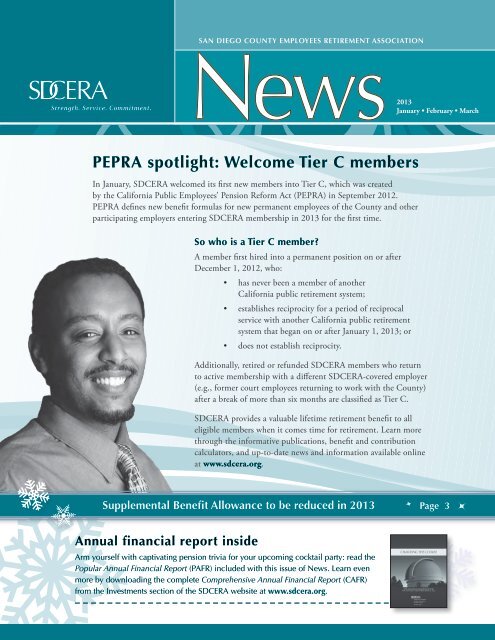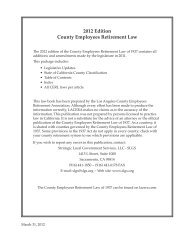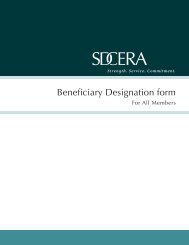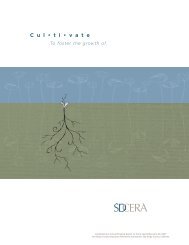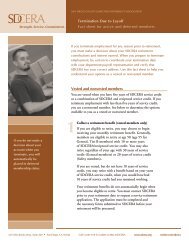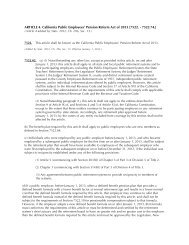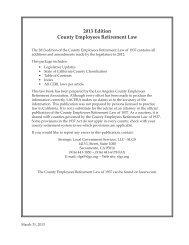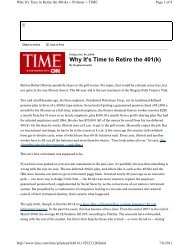Jan-Feb-Mar 2013 - sdcera
Jan-Feb-Mar 2013 - sdcera
Jan-Feb-Mar 2013 - sdcera
You also want an ePaper? Increase the reach of your titles
YUMPU automatically turns print PDFs into web optimized ePapers that Google loves.
SAN DIEGO COUNTY EMPLOYEES RETIREMENT ASSOCIATION<br />
Strength. Service. Commitment.<br />
<strong>2013</strong><br />
<strong>Jan</strong>uary • <strong>Feb</strong>ruary • <strong>Mar</strong>ch<br />
PEPRA spotlight: Welcome Tier C members<br />
In <strong>Jan</strong>uary, SDCERA welcomed its first new members into Tier C, which was created<br />
by the California Public Employees’ Pension Reform Act (PEPRA) in September 2012.<br />
PEPRA defines new benefit formulas for new permanent employees of the County and other<br />
participating employers entering SDCERA membership in <strong>2013</strong> for the first time.<br />
So who is a Tier C member?<br />
A member first hired into a permanent position on or after<br />
December 1, 2012, who:<br />
• has never been a member of another<br />
California public retirement system;<br />
• establishes reciprocity for a period of reciprocal<br />
service with another California public retirement<br />
system that began on or after <strong>Jan</strong>uary 1, <strong>2013</strong>; or<br />
• does not establish reciprocity.<br />
Additionally, retired or refunded SDCERA members who return<br />
to active membership with a different SDCERA‐covered employer<br />
(e.g., former court employees returning to work with the County)<br />
after a break of more than six months are classified as Tier C.<br />
SDCERA provides a valuable lifetime retirement benefit to all<br />
eligible members when it comes time for retirement. Learn more<br />
through the informative publications, benefit and contribution<br />
calculators, and up-to-date news and information available online<br />
at www.<strong>sdcera</strong>.org.<br />
Supplemental Benefit Allowance to be reduced in <strong>2013</strong> Page 3<br />
Annual financial report inside<br />
Arm yourself with captivating pension trivia for your upcoming cocktail party: read the<br />
Popular Annual Financial Report (PAFR) included with this issue of News. Learn even<br />
more by downloading the complete Comprehensive Annual Financial Report (CAFR)<br />
from the Investments section of the SDCERA website at www.<strong>sdcera</strong>.org.
Does SDCERA have your legal address?<br />
An updated address helps ensure correct<br />
tax withholding<br />
Your address is one of the most important pieces of<br />
information you can share with SDCERA. Keeping<br />
it updated allows SDCERA to correctly withhold<br />
required taxes.<br />
You’re able to provide both a mailing address and<br />
legal address. What’s the difference? Your mailing<br />
address is where you receive mail. Your legal address<br />
is the street address of your physical residence.<br />
The IRS requires SDCERA to have a legal (physical)<br />
address on file for every member. If retired members<br />
or beneficiaries have only provided a P.O. Box<br />
as their address, SDCERA is legally required to<br />
withhold their taxes at the “married plus three”<br />
rate—that is, the rate of withholding for a person<br />
who is married and has three dependents. A legal<br />
U.S. address on the Change of Address form and a<br />
valid tax election form (available at www.<strong>sdcera</strong>.org)<br />
are all SDCERA needs to clear up P.O. Box‐related<br />
tax issues. SDCERA does not withhold taxes for<br />
states other than California.<br />
Retired members to<br />
receive 1099-R forms<br />
SDCERA mails IRS Form<br />
1099-R to all retired<br />
members at the end of<br />
<strong>Jan</strong>uary. This form reports<br />
the total amount of income<br />
paid to you from SDCERA<br />
during the preceding<br />
calendar year. You will<br />
need this form to complete<br />
your federal and state tax<br />
returns. Be sure to check<br />
your mailbox for this<br />
important document.<br />
You can change your<br />
tax withholding at any<br />
time. A Tax Election for<br />
Monthly Retirement form<br />
will be mailed to you with<br />
your <strong>Feb</strong>ruary earnings<br />
statement. This form is also<br />
available at www.<strong>sdcera</strong>.org<br />
under Forms & Publications<br />
or by contacting the<br />
Call Center.<br />
Retired SDCERA members or beneficiaries who<br />
are U.S. citizens without a U.S. address on file<br />
must send SDCERA a completed IRS Form W-9.<br />
Other rules apply to SDCERA members who are<br />
non‐U.S. citizens residing outside the United States.<br />
U.S. citizens residing outside the U.S. receive the<br />
standard IRS Form 1099-R for tax reporting and<br />
may not opt out of tax withholding. (See sidebar.)<br />
Contact SDCERA to request a form, confirm your<br />
withholding amounts or request more information<br />
about retiring outside of California.<br />
2<br />
SAN DIEGO COUNTY EMPLOYEES RETIREMENT ASSOCIATION
Supplemental Benefit Allowance to reduce in <strong>2013</strong><br />
The Supplemental Benefit Allowance (SBA) is a nonvested benefit paid<br />
to eligible Tier A members who retire with 10 or more years of SDCERA<br />
service credit. Tier A members who are receiving a retirement based on a<br />
disability may also be eligible. The SBA is funded by excess earnings and<br />
existing reserves.<br />
The Board of Retirement has established a two-step reduction of the SBA<br />
in order to more efficiently distribute available funds for a longer period of<br />
time. The first reduction occurred in <strong>Jan</strong>uary 2011, lowering the maximum<br />
SBA amount to $350. The second reduction, lowering the maximum to<br />
$175, is currently projected to occur sometime this summer. This projection<br />
could change based on the rate of retirements in the first half of the year.<br />
When a date is set for the reduction, SDCERA will notify Tier A members.<br />
If you are unsure whether you receive the SBA, refer to your monthly<br />
statement. Members sometimes confuse the SBA (“SBA Taxable” on your<br />
earnings statement) with the health insurance allowance (“Medical Allowance<br />
Non-taxable” on your earnings statement), a nonvested benefit provided to<br />
Tier I and Tier II members to help offset health insurance premiums. These<br />
two benefits are unrelated.<br />
New insurance cards mailed in <strong>Jan</strong>uary<br />
Retired members and their dependents who enrolled<br />
in an SDCERA-sponsored health plan for the first time<br />
in November should receive insurance identification<br />
cards by mid-<strong>Jan</strong>uary. If you have not yet received<br />
your identification card, contact your plan carrier<br />
(e.g., Kaiser, Delta Dental). Contact information for<br />
carriers can be found online at www.<strong>sdcera</strong>.org or in<br />
SDCERA’s <strong>2013</strong> Health Insurance Plans booklet.<br />
<strong>2013</strong> JANUARY • FEBRUARY • MARCH<br />
3
Considering retirement?<br />
Four essentials for you to know<br />
1<br />
The SDCERA retirement calculator is invaluable<br />
Have your Annual Member Statement handy and fire up the Retirement Benefit<br />
Calculator at www.<strong>sdcera</strong>.org. See how your age, service credit and final average<br />
compensation will affect your benefit.<br />
Age factor is determined by your age at retirement. Service credit is a measure<br />
of time you have been an SDCERA member. Your final average compensation<br />
is based on either your highest one year of earnings (Tier I and Tier A) or your<br />
highest three years of earnings (Tier B and Tier C).<br />
Changing any of these factors may affect your benefit. Plug a few scenarios into<br />
the Retirement Benefit Calculator to discover the best retirement date for you.<br />
We want to hear from you<br />
Retirement seminars are offered throughout the year, providing an overview<br />
of retirement benefit options and health insurance information. (See sidebar.)<br />
2<br />
Once you pick your retirement date, SDCERA wants to hear from you.<br />
Contact the Call Center at 619.515.6800 about 60 days before your estimated<br />
retirement date to request an application.<br />
3<br />
Inflation? Meet the COLA<br />
The annual cost-of-living adjustment (COLA) is based on the Consumer Price<br />
Index (CPI) for San Diego, provided by the Bureau of Labor Statistics each<br />
<strong>Feb</strong>ruary. All retired members are eligible for the COLA: up to a 3% increase for<br />
Tier I, Tier II and Tier A members and up to a 2% increase for Tier B and Tier C<br />
members. Because the maximum allowable COLA is 2% or 3%, depending on<br />
your tier, any increase in the CPI beyond that maximum is placed in a COLA<br />
bank. This amount can be applied in a future year, when the CPI change is less<br />
than the maximum.<br />
Members retiring on or before <strong>Mar</strong>ch 31 are eligible for a COLA (if any) that<br />
year. Some members wait for the SDCERA COLA announcement before setting a<br />
retirement date. The Board of Retirement approves the COLA in early <strong>Mar</strong>ch.<br />
4<br />
SAN DIEGO COUNTY EMPLOYEES RETIREMENT ASSOCIATION
4<br />
You might miss working<br />
If you work anywhere other than the<br />
County (or participating employer)<br />
after retirement, your SDCERA<br />
benefits are not affected. But if you<br />
return to work with the County (or<br />
participating employer), keep the<br />
following in mind:<br />
• You must wait 180 calendar<br />
days (90 days for public safety<br />
officers) after retirement to<br />
return to work.<br />
• Work no more than 960<br />
hours per fiscal year. If you<br />
take a permanent position<br />
with the County (at least<br />
20 hours weekly), your<br />
retirement benefit payments<br />
stop and you re-enter active<br />
SDCERA membership.<br />
Find more information in the<br />
Working after Retirement fact sheet,<br />
available at www.<strong>sdcera</strong>.org.<br />
New Year’s resolution:<br />
Learn more about my<br />
retirement benefits<br />
SDCERA offers half‐day retirement<br />
and estate‐planning seminars<br />
throughout the year. Visit<br />
www.<strong>sdcera</strong>.org and click on<br />
“Seminars” for upcoming dates.<br />
Mid-career seminar<br />
• For members five to 20<br />
years from retirement<br />
• Offered monthly, some<br />
on Saturdays<br />
Late-career seminar<br />
• For members within one<br />
year of retiring<br />
• Offered monthly<br />
Estate-planning seminar<br />
• For active, deferred and<br />
retired members<br />
• Offered three times yearly<br />
<strong>2013</strong> JANUARY • FEBRUARY • MARCH<br />
5
New Board of Retirement member David B. Moore<br />
brings experience, objectivity<br />
David B. Moore attended an SDCERA Board of Retirement meeting as a visitor in<br />
early 2012 and was immediately impressed. “From the first minute, it was obvious that<br />
the Board members are extremely knowledgeable,” he says. “I’m very impressed with<br />
their level of experience and engagement.”<br />
Moore’s appointment to the Board of Retirement in November 2012 added to that<br />
collective knowledge and experience. He has more than 15 years of professional<br />
experience in the finance industry and has served on the boards of directors for several<br />
organizations. “I view serving on the Board of Retirement as not just a worthy public<br />
service mission, but also as an opportunity to engage in an activity I enjoy while giving something meaningful<br />
back to the county I call home,” he says.<br />
San Diego hasn’t always been home. Originally from New Orleans, Moore attended college and graduate<br />
schools in Virginia and Washington, D.C. He made his way to Southern California after working two years for<br />
a Chicago-based investment banking and investor services company. After five years with a private equity and<br />
merchant banking firm in Rancho Santa Fe, Moore launched his own investment partnership in San Diego.<br />
So much experience in the investment industry has helped him develop a farsighted perspective. “The Board is<br />
already ahead in the area of long-term planning. We’re already doing unconventional things—and that’s good!” he<br />
says. “I hope to encourage the Board to think even longer term, to plan even further out than we currently are.”<br />
Moore says he approaches his service on the SDCERA Board of Retirement with a focus on objectivity. “All<br />
the decisions we make need to be in the best interests of our members, and we also have a responsibility to the<br />
taxpayers,” he notes. “Our job is to balance the concerns of both groups.”<br />
Published for members of the<br />
San Diego County Employees<br />
Retirement Association<br />
Member comments and suggestions<br />
should be directed to SDCERA’s<br />
Communications Department.<br />
Email:<br />
communications@<strong>sdcera</strong>.org<br />
Call:<br />
619.515.6800<br />
888.4.SDCERA<br />
Send written inquiries to:<br />
SDCERA<br />
2275 Rio Bonito Way, Suite 200<br />
San Diego, CA 92108-1685<br />
Visit:<br />
www.<strong>sdcera</strong>.org<br />
8<br />
Follow us on Twitter:<br />
www.twitter.com/<strong>sdcera</strong><br />
Chief Executive Officer<br />
Brian P. White<br />
Board of Retirement<br />
David A. Myers<br />
Chairman<br />
<strong>Mar</strong>tin Cherry<br />
<strong>Mar</strong>c Doss<br />
Dianne Jacob<br />
Dan McAllister<br />
David B. Moore<br />
E.F. “Skip” Murphy<br />
Douglas Rose<br />
Dick Vortmann<br />
James W. Feeley<br />
(alternate retired)<br />
Timothy Hancock<br />
(alternate Safety)<br />
Retirement Board Meetings<br />
First and third Thursday of each month at the<br />
SDCERA Board Room, 2nd floor, 8:30 a.m.<br />
Visit www.<strong>sdcera</strong>.org to view meeting calendars,<br />
agendas, minutes and streaming video of Board of<br />
Retirement meetings.<br />
<strong>2013</strong> Electronic Deposit Retirement Payment Dates<br />
<strong>Jan</strong>uary 31; <strong>Feb</strong>ruary 28; <strong>Mar</strong>ch 29; April 30;<br />
May 31; June 28; July 31; August 30; September 30;<br />
October 31; November 29; December 31<br />
SDCERA makes every effort to meet the retirement<br />
payment schedule; however, please verify with your<br />
financial institution that each deposit has been<br />
made to your account.<br />
Observed Holidays (office closed)<br />
<strong>Jan</strong>uary 21; <strong>Feb</strong>ruary 18; April 1; May 27; July 4;<br />
September 2; November 11, 28, 29; December 25<br />
6<br />
SAN DIEGO COUNTY EMPLOYEES RETIREMENT ASSOCIATION
SDCERA selects Salient Partners<br />
as portfolio strategist<br />
SDCERA has signed a new contract with<br />
portfolio strategist Salient Partners after a<br />
six-month selection process. Salient Partners,<br />
whose original three-year contract expired<br />
in December 2012, was chosen for their<br />
understanding of SDCERA’s investment<br />
strategy, their experience in reducing<br />
investment risk, and their track record of<br />
strong investment returns. SDCERA’s new<br />
five-year contract with the 121‐person firm<br />
started <strong>Jan</strong>uary 1, <strong>2013</strong>.<br />
The portfolio strategist’s strong leadership<br />
contributes to the stability of the SDCERA<br />
fund. “Salient Partners is a talented group,”<br />
says SDCERA Chief Executive Officer Brian<br />
White. “Our fund’s portfolio, currently<br />
managed by Salient Partners, has held up<br />
well during a difficult economy by reducing<br />
risk and producing strong returns.” The new<br />
contract includes the service of 63 investment<br />
professionals and support staff at Salient—a<br />
significant increase in the staff and resources<br />
managing SDCERA’s investments.<br />
During the first 36 months of Salient<br />
Partners’ original contract, SDCERA<br />
reported an 11.4% return, outperforming<br />
its 8% assumed rate of return. Between<br />
July 1, 2009, and June 30, 2012, SDCERA’s<br />
portfolio, under the guidance of Salient<br />
Partners, outperformed 96% of its peers,<br />
with investment returns of 14% during an<br />
extremely challenging economy.<br />
As the economic challenges continue,<br />
Salient Partners’ emphasis on risk<br />
management is expected to help maintain<br />
SDCERA’s fund stability. “The new contract’s<br />
fee structure reflects an increase in the amount<br />
of staff and services provided to SDCERA<br />
by Salient Partners,” said White. “Their<br />
focus will be to generate strong long‐term<br />
investment returns while minimizing risk and<br />
decreasing the overall investment expenses of<br />
SDCERA’s portfolio.”<br />
Answers to<br />
frequently<br />
QA<br />
asked<br />
questions<br />
For more answers,<br />
please contact<br />
the Call Center<br />
at 619.515.6800<br />
to speak with<br />
a representative.<br />
Can I collect my Social Security benefit<br />
and my SDCERA benefit at the same time?<br />
Yes. If you are eligible for an SDCERA<br />
retirement benefit and a Social Security<br />
benefit, collecting one will not keep you<br />
from collecting the other.<br />
However, Safety members, who do not<br />
contribute to Social Security through their<br />
work at the County, may be affected by<br />
Social Security’s “Windfall Elimination<br />
Provision.” Visit www.socialsecurity.gov<br />
to learn more.<br />
This newsletter provides disclosure of certain terms<br />
and conditions of SDCERA membership and benefits<br />
available to members. It is designed to give you this<br />
information as simply and as accurately as possible<br />
as of the date of publication. SDCERA is governed<br />
by the County Employees Retirement Law of 1937<br />
(Government Code Section 31450 et seq.) and by<br />
the California Public Employees’ Pension Reform<br />
Act of <strong>2013</strong> (Government Code Section 7122 et<br />
seq.) as they have been adopted and implemented<br />
by the San Diego County Board of Supervisors<br />
and the SDCERA Board of Retirement. If there is<br />
any inconsistency between this newsletter and<br />
the governing law, the law will govern. Decisions<br />
relating to the plan will be made after reference to<br />
the statutes and any resolutions, regulations and<br />
policies governing administration of SDCERA as<br />
they exist at the same time of the decisions.<br />
<strong>2013</strong> JANUARY • FEBRUARY • MARCH<br />
7
San Diego County Employees Retirement Association<br />
2275 Rio Bonito Way, Suite 200<br />
San Diego, CA 92108-1685<br />
PRSRT STD<br />
U.S. POSTAGE<br />
PAID<br />
PDM<br />
Investment report<br />
%$ The SDCERA fund’s<br />
focus on diversification is paying off.<br />
Over the three-year period ended<br />
September 30, 2012, SDCERA<br />
outperformed its peers, according<br />
to the Wilshire Trust Universe<br />
Comparison Service (TUCS). The<br />
fund generated an 11.4% annualized<br />
rate of return over that period,<br />
outpacing its benchmark return of<br />
10.2%, the median fund return of<br />
9.5%, and the fund’s 8.0% assumed<br />
rate of return.<br />
In the third quarter of 2012,<br />
the European debt crisis, the<br />
approaching fiscal cliff and central<br />
bank stimulus signified a world‐wide<br />
syndrome of unsustainable debt.<br />
In mid‐September, the Federal<br />
Reserve offered evidence that it was<br />
going to try to inflate its way out<br />
of debt by increasing the supply of<br />
money in circulation for the third<br />
time since 2008, with the purpose<br />
of stimulating lending and<br />
encouraging economic growth.<br />
Despite the volatile environment,<br />
SDCERA’s approach to<br />
diversification produced promising<br />
returns. For the quarter ended<br />
September 30, 2012, SDCERA’s<br />
portfolio generated a positive<br />
4.8% return. Each of the three<br />
major components of the overall<br />
portfolio contributed positive<br />
returns to the fund as a whole.<br />
Returns for quarter ended September 30, 2012 (gross of fees)<br />
Total assets under management: $9,127,564,595.<br />
SDCERA Returns Quarter 1–Year 3–Year 5–Year<br />
Growth oriented 1<br />
Growth oriented benchmark<br />
Stable value 2<br />
Stable value benchmark<br />
Inflation sensitive 3<br />
Inflation sensitive benchmark<br />
Total fund<br />
Total fund benchmark<br />
5.7%<br />
5.7%<br />
2.5%<br />
1.5%<br />
3.8%<br />
5.2%<br />
4.8%<br />
4.6%<br />
20.4%<br />
21.3%<br />
7.2%<br />
5.0%<br />
12.9%<br />
15.0%<br />
17.3%<br />
15.9%<br />
1<br />
Global, Emerging <strong>Mar</strong>ket, Private Equities, and High Yield Bonds<br />
8.8%<br />
9.0%<br />
8.7%<br />
6.7%<br />
10.7%<br />
11.0%<br />
11.4%<br />
10.2%<br />
0.5%<br />
0.0%<br />
8.3%<br />
6.9%<br />
2.6%<br />
4.3%<br />
2.7%<br />
3.4%<br />
2<br />
Emerging <strong>Mar</strong>ket Debt (Local), Global Macro CTAs, Relative Value, and U.S. Treasuries<br />
3<br />
Real Estate, Natural Resources and Other Real Assets, and Treasury Inflation Protected Securities<br />
8<br />
SAN DIEGO COUNTY EMPLOYEES RETIREMENT ASSOCIATION


